Claire Mabey – 9 April, 2014
Literature on Parkes' work often discusses the organic and sexual nature of her sculptural painting. It seems that if the artist is a woman whose work has organic connotations there is a natural progression toward sexuality and the expression of feminine and masculine stereotypes. 'Whopper' could lead to the same discussion. However it is the negation of colour and the resistance to spatial conformity that leads to a more interesting reading.
The atrium of the Tauranga Art Gallery is a unique space - it’s huge, it’s light, and every work commissioned entirely alters the visitor experience of entering the gallery. Miranda Parkes is the latest artist to transform the atrium and has done so with Whopper. A playful name for a work that bursts with the tension between a challenge and having fun.
Whopper took two weeks to install and is created using a paint-by-sections scheme for the atrium walls, and a scrunched up painted canvas of nearly 60 square metres installed into the intersection of the two principal walls. The canvas replaces the corner - tumbling and crunching from the top to the floor - being an architectural interruption to the space. This cacophony of colour, lines, bulges and sagging folds is an intersection of action. It looks like hot air balloons, or circus tents have been stitched together - the effect is energetic, but confusing. The two walls on either side of this bulging interruption are perfectly symmetrical. Sharp, scalene triangles thrust into lines of acidic green; lines of orange, red, yellow and silver follow on up the walls to be intruded upon by deep purple triangles and softer lilac shapes.
The palette at first seems joyous - the lines, triangles and rounder shapes give form and shape to the strong colours. But the tones are at odds, particularly the recurrent acid green that has connotations of illness. Furthermore the combinations of shape and hue are almost aggressive; the triangles are intensely sharp spears and the puffed out tumbling forms of the canvas that fall so voluptuously through the symmetry of the walls is an abrupt textural contrast.
A closer look at the canvas reveals spots and smears of paint. Unlike the walls on either side, which are so perfectly uncontaminated they’re severe, it barely contains its chaos - being pattern and design messed around with. The smudges and drops of colour draw on abstract expressionism. However, in the context of Whopper, the abstraction and the effects of the painting process is an almost child-like comfort - it is the joy of applying colour to canvas and the fun of scrunching something meant to be flat and rectangular. It is the negation of authority and control.
Literature on Parkes‘ work often discusses the organic and sexual nature of her sculptural painting. It seems that if the artist is a woman whose work has organic connotations there is a natural progression toward sexuality and the expression of feminine and masculine stereotypes.
Whopper could lead to the same discussion - the curves and folds and collision of pattern and paint spots and smears is a wonderful, fleshy intrusion on the austere perfection of the shapes on either side. However it is the negation of colour and the resistance to spatial conformity that leads to a more interesting reading. The colours are far from organic. The combinations are clashing and commercial - the orange, purple and reds of advertising and of vinyl outdoor furniture or bouncy castles. They argue against an organic palate, those tones we consider to be so inherent to the New Zealand painting canon.
Whopper is defiant. It first creates conformity and then deconstructs it. Patterns fall away when the wall runs out, and the great, chaotic canvas does away with corners and certainty. Parkes appears to have had fun - on a huge scale - but she is also seriously challenging the way we think about painting and the politics generated from the way it is defined.
Claire Mabey
Recent Comments
Owen Pratt
Sorry did I say big lie I meant big thighs.
Owen Pratt
A BIG LIE? or How could you possibly improve the WHOPPER®? Make it bigger. Two flame grilled beef patties, juicy ...
Andrew Paul Wood
"It seems that if the artist is a woman whose work has organic connotations there is a natural progression toward ...
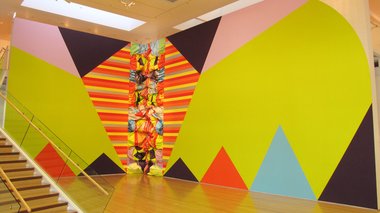
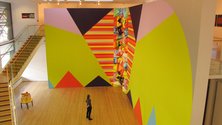

 Two Rooms presents a program of residencies and projects
Two Rooms presents a program of residencies and projects Advertising in this column
Advertising in this column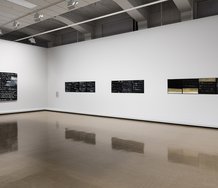
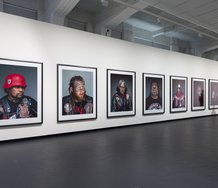
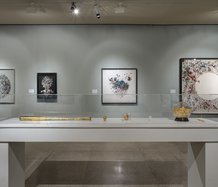
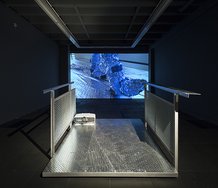
This Discussion has 3 comments.
Comment
Andrew Paul Wood, 8:57 p.m. 9 April, 2014 #
"It seems that if the artist is a woman whose work has organic connotations there is a natural progression toward sexuality and the expression of feminine and masculine stereotypes."
Actually that's almost enevitable for any artist in history whose work has organic connotations, regardless of gender, especially the modern art movement post Freudian analysis. No anti-feminist conspiracy there. Look at Manet, Rodin, Picasso, Courbet
I would also note that Parkes is quite open about the reference to "feminine and masculine stereotypes" in her work, which is why it often gets brought up in the literature.
Owen Pratt, 4:10 p.m. 12 April, 2014 #
A BIG LIE? or
How could you possibly improve the WHOPPER®? Make it bigger. Two flame grilled beef patties, juicy tomatoes, crisp lettuce, creamy mayo, ketchup, pickles and onions. Twice as tasty.
Owen Pratt, 4:12 p.m. 12 April, 2014 #
Sorry did I say big lie I meant big thighs.
Participate
Register to Participate.
Sign in
Sign in to an existing account.